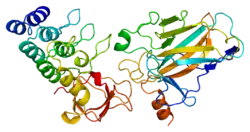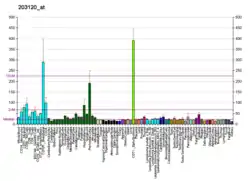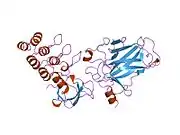TP53BP2
Apoptosis-stimulating of p53 protein 2 (ASPP2) also known as Bcl2-binding protein (Bbp) and tumor suppressor p53-binding protein 2 (p53BP2) is a protein that in humans is encoded by the TP53BP2 gene.[5][6][7] Multiple transcript variants encoding different isoforms have been found for this gene.
Nomenclature
ASPP2 (amino acid residues 600 –1128) was initially identified as 53BP2 (p53-binding protein 2) in a yeast two hybrid screen using p53 as the bait.[6] Another yeast two hybrid screening in which Bcl-2 was used as the bait gave rise to the discovery of another fragment of ASPP2 (residues 123-1128) and it was called Bbp.[5] The full length ASPP2 (1128 amino acids) was identified later.[8]
Function
ASPP2 plays a central role in regulation of apoptosis and cell growth via its interactions. ASPP2 regulates TP53 by enhancing the DNA binding and transactivation function of TP53 on the promoters of proapoptotic genes in vivo.[8] ASPP2 binds to wild-type p53 but fails to bind to mutant p53, suggesting that ASPP2 may be involved in the ability of wild-type p53 to suppress transformation.[6] ASPP2 induces apoptosis but no cell cycle arrest.[8]
Structure
ASPP2 contains several structural and functional domains. Its N-terminus (residues 1–83) has the structure of a β-grasp ubiquitin-like fold.[9][10] It is followed by a predicted α-helical domain located between aa 123 and 323.[5] and a proline-rich (ASPP2 Pro) domain between aa 674 and 902.[5] The C-terminal part of ASPP2 contains four ankyrin repeats and an SH3 domain involved in protein-protein interactions.[10][11] ASPP2 is found in the perinuclear region of the cytoplasm.[12][13]
Family members
The ASPP family includes ASPP1, ASPP2, and iASPP. The name ASPP stands for apoptosis stimulating protein of p53, the name emphasizes the ankyrin repeats, SH3 domain, and proline-rich domains that characterize this family.[8] The three family members come from different genes but ASPP1 and ASPP2 share a greater sequence similarity than either does with iASPP as the N terminus of iASPP has no homology with ASPP1 and ASPP2. The sequence similarities among ASPP family members indicates that ASPP1 and ASPP2 probably have similar biological functions that differ from that of iASPP.[14] The family plays a key role in apoptosis regulation in the intrinsic and extrinsic apoptotic pathways.[8][15] ASPP1 and ASPP2 promote, while iASPP inhibits, apoptosis.[16]
Binding partners
ASPP2 is the ASPP family member with the most known binding partners. The highly conserved C-terminus was first known to bind to p53 through its ankyrin repeats and SH3 domain in 1994 by a yeast two hybrid system and it was called p53 Binding Protein 2 (53BP2).[6] Other binding partners have been discovered through the years, indicating the importance of the ankyrin repeats and SH3 domains for protein-protein interactions. Some of the known binding partners of ASPP2 include BCL2, p63, p73, Hepatitis C virus core protein, Amyloid-b-Precursor Protein-Binding Protein 1 (APP-BP1), YES-Associated Protein (YAP), Adenomatosis Polyposis Coli 2 (APC2), RelA/p65, Protein Phosphatase 1 (PP1)[17] and NFκB (p65)[18]
Expression
The expression of ASPP2 is encoded by the gene TP53BP2 and is located in the long arm of chromosome 1 at q42.1. Northern-blot analyses showed that the ASPP2/53BP2 mRNA was expressed in many human tissues such as heart, brain, placenta, lung, liver, skeletal muscle, kidney, pancreas, but at varying levels. The highest expression level of ASPP2 was detected in skeletal tissue.[6][14]
Clinical significance
ASPP2 was first associated with human cancer when the crystal structure of p53 binding domain bound to the C-terminal ankyrin repeats and SH3 domain of ASP2. All the amino acids of p53 that are important for binding ASPP2 are mutated in human cancers.[14] ASPP2 expression levels have been associated with cellular sensitivity to apoptosis.[8] ASPP2 importance in human malignancies is emphasized by studies that show that downregulation of ASPP2 is commonly found in tumors and carcinoma cells expressing wild type p53, and to a lesser extent mutant p53.[19][20] For example, it was found to be downregulated in both metastatic and invasive cells as compared to normal breast epithelium.[20] It has been demonstrated the binding of ASPP2 to bcl-2 and p53 and to impede cell cycle progression at G2-M,[5] as well as the fact that binding of ASPP2 to p53 changes the conformation of p53 and increases p53 binding to the promoters of proapoptotic genes such as Bax and PIG-3 but not those of G1-arrest genes such as p21waf1.[8][21] Single nucleotide polymorphisms of ASPP2 have also shown to be associated with predisposition of gastric cancer development.[21] These could be due to the fact that ASPP2 is also a tumor suppressor as well as an activator of p53.[17]
Levels of expression of ASPP2 are important, high levels of expression play an important role in inducing apoptosis independently of p53, mediated by p63 and p73. The expression is enhanced in response to DNA damage.[22][23] On the other hand, silencing of ASPP2 expression by methylation was observed in several human carcinoma cells.[19]
References
- GRCh38: Ensembl release 89: ENSG00000143514 - Ensembl, May 2017
- GRCm38: Ensembl release 89: ENSMUSG00000026510 - Ensembl, May 2017
- "Human PubMed Reference:". National Center for Biotechnology Information, U.S. National Library of Medicine.
- "Mouse PubMed Reference:". National Center for Biotechnology Information, U.S. National Library of Medicine.
- Naumovski L, Cleary ML (Aug 1996). "The p53-binding protein 53BP2 also interacts with Bc12 and impedes cell cycle progression at G2/M". Mol Cell Biol. 16 (7): 3884–92. doi:10.1128/MCB.16.7.3884. PMC 231385. PMID 8668206.
- Iwabuchi K, Bartel PL, Li B, Marraccino R, Fields S (Jul 1994). "Two cellular proteins that bind to wild-type but not mutant p53". Proc Natl Acad Sci U S A. 91 (13): 6098–102. doi:10.1073/pnas.91.13.6098. PMC 44145. PMID 8016121.
- "Entrez Gene: TP53BP2 tumor protein p53 binding protein, 2".
- Samuels-Lev Y, O'Connor DJ, Bergamaschi D, Trigiante G, Hsieh JK, Zhong S, Campargue I, Naumovski L, Crook T, Lu X (October 2001). "ASPP proteins specifically stimulate the apoptotic function of p53". Mol Cell. 8 (4): 781–94. doi:10.1016/S1097-2765(01)00367-7. PMID 11684014.
- Tidow H, Andreeva A, Rutherford TJ, Fersht AR (August 2007). "Solution structure of ASPP2 N-terminal domain (N-ASPP2) reveals a ubiquitin-like fold". J Mol Biol. 371 (4): 948–58. CiteSeerX 10.1.1.334.9857. doi:10.1016/j.jmb.2007.05.024. PMID 17594908.
- Rotem S, Katz C, Benyamini H, Lebendiker M, Veprintsev D, Rüdiger S, Danieli T, Friedler A (April 2008). "The structure and interactions of the proline-rich domain of ASPP2". J Biol Chem. 283 (27): 18990–9. doi:10.1074/jbc.M708717200. PMID 18448430.
- Gorina S, Pavletich NP (November 1996). "Structure of the p53 tumor suppressor bound to the ankyrin and SH3 domains of 53BP2". Science. 274 (5289): 1001–5. doi:10.1126/science.274.5289.1001. PMID 8875926.
- Nakagawa H, Koyama K, Murata Y, Morito M, Akiyama T, Nakamura Y (Jan 2000). "APCL, a central nervous system-specific homologue of adenomatous polyposis coli tumor suppressor, binds to p53-binding protein 2 and translocates it to the perinucleus". Cancer Res. 60 (1): 101–5. PMID 10646860.
- Uhlmann-Schiffler H, Kiermayer S, Stahl H (May 2009). "The DEAD box protein Ddx42p modulates the function of ASPP2, a stimulator of apoptosis". Oncogene. 28 (20): 2065–73. doi:10.1038/onc.2009.75. PMID 19377511.
- Trigiante G, Lu X (March 2006). "ASPP [corrected] and cancer". Nature Reviews Cancer. 6 (3): 217–26. doi:10.1038/nrc1818. PMID 16498444.
- Kobayashi S, Kajino S, Takahashi N, Kanazawa S, Imai K, Hibi Y, Ohara H, Itoh M, Okamoto T (March 2005). "53BP2 induces apoptosis through the mitochondrial death pathway". Genes Cells. 10 (3): 253–60. doi:10.1111/j.1365-2443.2005.00835.x. PMID 15743414.
- Benyamini H, Friedler A (March–April 2011). "The ASPP interaction network: electrostatic differentiation between pro- and anti-apoptotic proteins". J Mol Recognit. 24 (2): 266–74. doi:10.1002/jmr.1048. PMID 20623514.
- Vives V, Slee EA, Lu X (October 2006). "ASPP2: a gene that controls life and death in vivo". Cell Cycle. 5 (19): 2187–90. doi:10.4161/cc.5.19.3266. PMID 16969108.
- Yang JP, Hori M, Takahashi N, Kawabe T, Kato H, Okamoto T (September 1999). "NF-kappaB subunit p65 binds to 53BP2 and inhibits cell death induced by 53BP2". Oncogene. 18 (37): 5177–86. doi:10.1038/sj.onc.1202904. PMID 10498867.
- Liu ZJ, Lu X, Zhang Y, Zhong S, Gu SZ, Zhang XB, Yang X, Xin HM (March 2005). "Downregulated mRNA expression of ASPP and the hypermethylation of the 5'-untranslated region in cancer cell lines retaining wild-type p53". FEBS Lett. 579 (7): 1587–90. doi:10.1016/j.febslet.2005.01.069. PMID 15757645.
- Sgroi DC, Teng S, Robinson G, LeVangie R, Hudson JR Jr, Elkahloun AG (November 1999). "In vivo gene expression profile analysis of human breast cancer progression". Cancer Res. 59 (22): 5656–61. PMID 10582678.
- Ju H, Lee KA, Yang M, Kim HJ, Kang CP, Sohn TS, Rhee JC, Kang C, Kim JW (December 2005). "TP53BP2 locus is associated with gastric cancer susceptibility". Int J Cancer. 117 (6): 957–60. doi:10.1002/ijc.21281. PMID 15986435.
- Bergamaschi D, Samuels Y, Jin B, Duraisingham S, Crook T, Lu X (February 2004). "ASPP1 and ASPP2: common activators of p53 family members". Mol Cell Biol. 24 (3): 1341–50. doi:10.1128/MCB.24.3.1341-1350.2004. PMC 321425. PMID 14729977.
- Slee EA, O'Connor DJ, Lu X (April 2004). "To die or not to die: how does p53 decide?". Oncogene. 23 (16): 2809–18. doi:10.1038/sj.onc.1207516. PMID 15077144.
Further reading
- Liu ZJ, Lu X, Zhong S (2005). "ASPP--Apoptotic specific regulator of p53". Biochim. Biophys. Acta. 1756 (1): 77–80. doi:10.1016/j.bbcan.2005.08.002. PMID 16139958.
- Helps NR, Barker HM, Elledge SJ, Cohen PT (1996). "Protein phosphatase 1 interacts with p53BP2, a protein which binds to the tumour suppressor p53". FEBS Lett. 377 (3): 295–300. doi:10.1016/0014-5793(95)01347-4. PMID 8549741.
- Gorina S, Pavletich NP (1996). "Structure of the p53 tumor suppressor bound to the ankyrin and SH3 domains of 53BP2". Science. 274 (5289): 1001–5. doi:10.1126/science.274.5289.1001. PMID 8875926.
- Pirozzi G, McConnell SJ, Uveges AJ, et al. (1997). "Identification of novel human WW domain-containing proteins by cloning of ligand targets". J. Biol. Chem. 272 (23): 14611–6. doi:10.1074/jbc.272.23.14611. PMID 9169421.
- Yang JP, Ono T, Sonta S, et al. (1997). "Assignment of p53 binding protein (TP53BP2) to human chromosome band 1q42.1 by in situ hybridization". Cytogenet. Cell Genet. 78 (1): 61–2. doi:10.1159/000134630. PMID 9345910.
- Iwabuchi K, Li B, Massa HF, et al. (1998). "Stimulation of p53-mediated transcriptional activation by the p53-binding proteins, 53BP1 and 53BP2". J. Biol. Chem. 273 (40): 26061–8. doi:10.1074/jbc.273.40.26061. PMID 9748285.
- Yang JP, Hori M, Takahashi N, et al. (1999). "NF-kappaB subunit p65 binds to 53BP2 and inhibits cell death induced by 53BP2". Oncogene. 18 (37): 5177–86. doi:10.1038/sj.onc.1202904. PMID 10498867.
- Scanlan MJ, Gordan JD, Williamson B, et al. (1999). "Antigens recognized by autologous antibody in patients with renal-cell carcinoma". Int. J. Cancer. 83 (4): 456–64. doi:10.1002/(SICI)1097-0215(19991112)83:4<456::AID-IJC4>3.0.CO;2-5. PMID 10508479.
- Mori T, Okamoto H, Takahashi N, et al. (2000). "Aberrant overexpression of 53BP2 mRNA in lung cancer cell lines". FEBS Lett. 465 (2–3): 124–8. doi:10.1016/S0014-5793(99)01726-3. PMID 10631318.
- Nakagawa H, Koyama K, Murata Y, et al. (2000). "APCL, a central nervous system-specific homologue of adenomatous polyposis coli tumor suppressor, binds to p53-binding protein 2 and translocates it to the perinucleus". Cancer Res. 60 (1): 101–5. PMID 10646860.
- Lopez CD, Ao Y, Rohde LH, et al. (2000). "Proapoptotic p53-interacting protein 53BP2 is induced by UV irradiation but suppressed by p53". Mol. Cell. Biol. 20 (21): 8018–25. doi:10.1128/MCB.20.21.8018-8025.2000. PMC 86412. PMID 11027272.
- Espanel X, Sudol M (2001). "Yes-associated protein and p53-binding protein-2 interact through their WW and SH3 domains". J. Biol. Chem. 276 (17): 14514–23. doi:10.1074/jbc.M008568200. PMID 11278422.
- Kajkowski EM, Lo CF, Ning X, et al. (2001). "beta -Amyloid peptide-induced apoptosis regulated by a novel protein containing a g protein activation module". J. Biol. Chem. 276 (22): 18748–56. doi:10.1074/jbc.M011161200. PMID 11278849.
- Samuels-Lev Y, O'Connor DJ, Bergamaschi D, et al. (2001). "ASPP proteins specifically stimulate the apoptotic function of p53". Mol. Cell. 8 (4): 781–94. doi:10.1016/S1097-2765(01)00367-7. PMID 11684014.
- Strausberg RL, Feingold EA, Grouse LH, et al. (2003). "Generation and initial analysis of more than 15,000 full-length human and mouse cDNA sequences". Proc. Natl. Acad. Sci. U.S.A. 99 (26): 16899–903. doi:10.1073/pnas.242603899. PMC 139241. PMID 12477932.
- Chen Y, Liu W, Naumovski L, Neve RL (2003). "ASPP2 inhibits APP-BP1-mediated NEDD8 conjugation to cullin-1 and decreases APP-BP1-induced cell proliferation and neuronal apoptosis". J. Neurochem. 85 (3): 801–9. doi:10.1046/j.1471-4159.2003.01727.x. PMID 12694406.
- Bergamaschi D, Samuels Y, Jin B, et al. (2004). "ASPP1 and ASPP2: common activators of p53 family members". Mol. Cell. Biol. 24 (3): 1341–50. doi:10.1128/MCB.24.3.1341-1350.2004. PMC 321425. PMID 14729977.
- Takahashi N, Kobayashi S, Jiang X, et al. (2004). "Expression of 53BP2 and ASPP2 proteins from TP53BP2 gene by alternative splicing". Biochem. Biophys. Res. Commun. 315 (2): 434–8. doi:10.1016/j.bbrc.2004.01.079. PMID 14766226.






